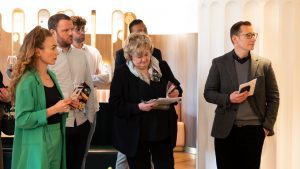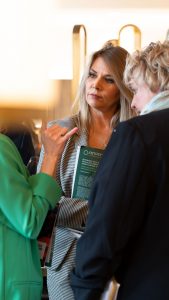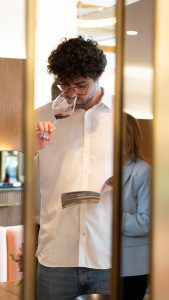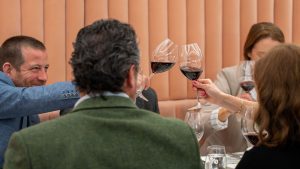Showcasing Rioja! Rioja wine sales on the Irish market

Rioja is classified by three zones; Rioja Alavesa, Rioja Alta and Rioja Oriental and at the Rioja tasting and lunch, guests were invited to taste wines from Bodegas Ollauri from the Rioja Alta zone, Arizcuren Bodegas y Viñedos from the Rioja Oriental zone, Valserrano from the Rioja Alavesa zone and Campo Viejo that produces wines with grapes from all three zones.
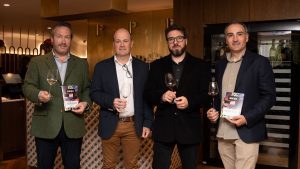
The winemakers: Pablo de Simón from Valserrano, Chema Ryan from Bodegas Ollauri, Ignacio Lopez from Campo Viejo and Javier Arizcuren from Arizcuren
Well-known wine expert Jean Smullen hosted the event and facilitated the discussion on all things Rioja among a distinguished crowd from across suppliers, the off trade and the on trade. In attendance and there to guide the guests during the pre-dinner tasting were the winemakers Chema Ryan from Bodegas Ollauri, Pablo de Simon from La Marquesa, Ignacio Lopez from Campo Viejo and Javier Arizcuren from Arizcuren. Peter Arijs, educational manager from the Rioja Control Board, spoke about the 100 km of diversity that makes Rioja such a unique and interesting region.
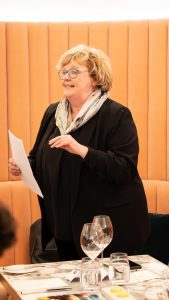
Jean Smullen was the MC for the event
As an introduction, Smullen recalls the first time she visited the Rioja region 21 years ago when things were still quite traditional and white wines were known for their more oxidative style. “A further decade on and the innovations introduced have been ground-breaking,” she says. “These include the new geographical indications, Viñedos Singulares (single vineyard wines), Vinos de Zona (regional specific wines), Vinos de Municipio (village wines) and sparkling wine production in the region, (Espumosos de Calidad de Rioja).” She explains how Rioja is bursting with innovation, new methods and varieties. “The changes have helped to create a fresh look but how much does the consumer know about Viñedo Singular, Vinos de Zona or Vinos de Municipios? Are they aware that the term ‘joven’ has been replaced by ‘generic or generico’, and that some of the most exciting wines of the region are produced under this label? We need to look at how these changes help to create a new identity for the region’s wines,” she says. Irish customers are sensitive to varietal labelling and customers wine buying choices are influenced by grape variety followed close behind by brand and country of origin, according to Wine Intelligence, Vinitrac® Ireland, Oct 2019. This is evident in the wines of Arizcuren. Javier Arizcuren says that they choose to work with the varieties that are most suited for Rioja Oriental and then label them by variety.
Spain’s finest wine
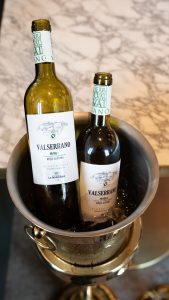
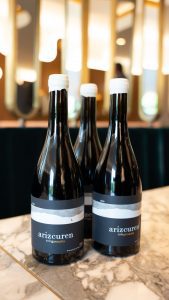
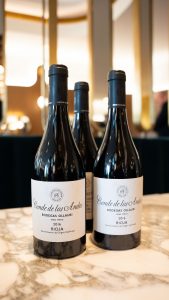
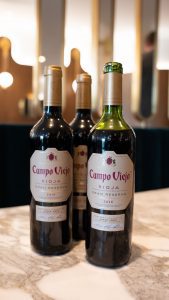
100 kilometers of diversity: Picked especially by the winemakers, guests had the chance to taste Valserrano Blanco from Bodegas de la Marquesa, Solo Garnacha from Arizcuren Bodega y Viñedos, Conde de los Andes from Bodegas Ollauri and a Gran Reserva from Campo Viejo
The Rioja region spreads across 100km in length, and is a melting pot of climates, valleys, villages, landscapes, grape varieties, colours and styles of wine. Leading wine critic Pedro Ballesteros Torres MW says of Rioja, “Rioja is not a type of wine. It is a whole wine country”. Rioja is one of the top international wine regions in terms of traceability, quality and transparency. Historically, its control regulations and technical approach have been the role model for other wine-growing regions in Spain. Its commitment to exclusively releasing wines that are ready to drink has positioned Rioja amongst the most internationally admired wine regions. Rioja has been recognised historically for its barrel-aged reds, but it also has many other styles of red, white, rosé and sparkling wines. The 14 permitted grape varieties are an inexhaustible source of nuances and expressions for its winemakers.
 Chema Ryan from Bodegas Ollauri says that white varietals are fresher like the Malvasia and Pablo de Simón from La Marquesa favours Viura. Considered to be a good choice because of its consistency and quality, Rioja creates a unique selling point but with so much competition in the Spanish wine market, how do Rioja’s producers ensure that they translate the quality and diversity of the product to the trade and consumers? Ignacio Lopez, chief winemaker with Campo Viejo explains what he believes differentiates Rioja from other Spanish regions. “From my point of view diversity is what makes Rioja unique as a wine region,” he says. “Diversity in soils, climate, vines orientation, trellising systems, altitude, and varieties. Rioja is a great combination of a rich legacy and old tradition of winemaking and the huge potential to produce the most modern, and bold wines; from vibrant whites and rosés to super attractive reds in many different styles. In Campo Viejo we benefit from that diversity by having vineyards all across the region that allow us to blend unique grapes to craft our wines.”
Chema Ryan from Bodegas Ollauri says that white varietals are fresher like the Malvasia and Pablo de Simón from La Marquesa favours Viura. Considered to be a good choice because of its consistency and quality, Rioja creates a unique selling point but with so much competition in the Spanish wine market, how do Rioja’s producers ensure that they translate the quality and diversity of the product to the trade and consumers? Ignacio Lopez, chief winemaker with Campo Viejo explains what he believes differentiates Rioja from other Spanish regions. “From my point of view diversity is what makes Rioja unique as a wine region,” he says. “Diversity in soils, climate, vines orientation, trellising systems, altitude, and varieties. Rioja is a great combination of a rich legacy and old tradition of winemaking and the huge potential to produce the most modern, and bold wines; from vibrant whites and rosés to super attractive reds in many different styles. In Campo Viejo we benefit from that diversity by having vineyards all across the region that allow us to blend unique grapes to craft our wines.”
Are the individual wineries and the producers the attraction when it comes to Rioja or is the region and its traditional styles still the main draw we wondered? “There is place for everyone in Rioja and a wine for every wine lover. You will find the traditional style that made Rioja what it is today, but a lot of new and exciting wines are rising to show anew face of Rioja. It is a great moment for wine drinkers to be looking after Riojas wine scene, for the past, the present and the future,” says Lopez.
Trading up

“Millennials and Gen Z generally seek out Rioja as a wine that can be trusted and have learned this from their parents and families, ”Louise Doyle, operations manager, Shanahan’s on the Green
Sales of Spanish wine in the off trade (which accounts for over 80% of all wine sales in Ireland) are 4th overall with an 11.8% market share of retail sales. Rioja Reserva is the most popular aged style and in 2022 sales of Reserva wines accounted for 41.5% of all Rioja wine sold here. This was followed by wines without ageing designation 35.5%, Crianza 18.4% and Gran Reserva 4.4%. (Source: Grupo Rioja) Consumers traded up in the off trade during Covid because they had more disposable income as they were notable to dine out or travel. According to Cathal McHugh of McHugh’s Off licence Artane, Winner of the Irish Off Licence of the Year 2023, despite consumers being mindful of spend, most of them won’t trade down after experiencing better quality wines.
Two of the key Rioja wine brands on the Irish market performed very well during this period. Campo Viejo performed well for the period March 2021 to March 2022 moving up a position to 11th thanks to very strong volume sales during 2021/22 according to the Top 20 Wine Brands in Ireland. Overall volume sales of their range increased by 10.5%, the second highest for any brand in that time scale. Also, Faustino (14th position up from 15th in 2021) performed well and increased its volume sales on the Irish market by 0.4% for the period March 2021 – March 2022.
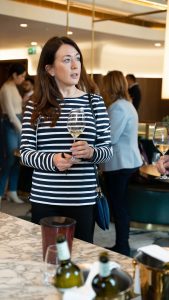
Nisea Doddy, hotel sommelier, The Shelbourne, Dublin
Nisea Doddy, hotel sommelier, The Shelbourne, Dublin agrees that quality has become more important since Covid. “So many wine drinkers were spending more in local wine merchants than usual. People certainly seem to have developed more curiosity and knowledge and will trade up more readily, having one great bottle instead of two middle of the road pricewise,” she explains.
Gutier Becheras from the French Paradox Wine Shop and Tasting Room in Dublin has noticed an increase in the average spend per bottle in the shop since Covid and says customers are definitely drawn to Rioja wines. “Our customers generally associate Rioja with medium to premium range wines,” he says.
However, Ann Moran of Gibney’s Wine Specialist Malehide is of the opinion that despite customers certainly choosing quality over quantity during Covid things have changed a bit since. “Since there opening of travel, restaurants etc not to mention the rise in cost of living we have noticed that the spend has reduced for personal consumption, however gifting remains in the quality bracket.”
So, can consumer focused promotions help the independent off trade to encourage the consumers to continue trading up and help to create greater awareness for the more premium wines from the region? Will Mullin, managing director of WineOnline.ie explains that they ran a Rioja Festival last year and introduced consumers to new wineries making modern styles of Rioja. “There were over 100 wines shown at the consumer event. Thes ales that followed were not the main brands making traditional Rioja. The sales were modern styled and more expensive wines that showed a new quality and style to them. I think the key is more consumer-focused promotion rather than merely trade. The trade is aware of the changes but by creating a new demand with the consumer, the trade will react anyway, bringing consumers what they are demanding in both the on and the off trade. We saw that first-hand with the consumer-focused Rioja Festival in October 2022.”
Legislation and innovation
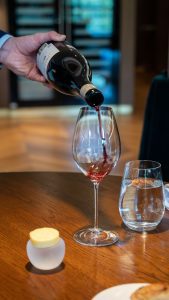 As mentioned earlier, Rioja is going through a period of re-invention. In 2019 the region introduced new legislation that included new geographical indications, Viñedos Singulares (single vineyard wines);Vinos de Zona (regional specific wines) and Vinos de Municipio which allowed the name of a specific village to be included on the label. Sparkling wine is now also being produced in Rioja (Espumosos de Calidad de Rioja). Lopez believes that these new geographical indications can actually help sales of fine wine. “They are a good way to focus on the origin to showcase Rioja’s diversity. They are a powerful tool for consumers who want to go deeper into terroir singular expressions,” he says. Four years after their implementation we wondered if those in the trade were aware of these new wine categories and whether they have been actively selling them and creating awareness with their customers. Will Mullin, managing director ofWineOnline.ie feels like there is more education needed. “Viñedo singular is gaining a small amount of traction slowly, and sparkling is something we have not had any traction on yet. It has been one way for so very long, that these changes will take time,” he says.
As mentioned earlier, Rioja is going through a period of re-invention. In 2019 the region introduced new legislation that included new geographical indications, Viñedos Singulares (single vineyard wines);Vinos de Zona (regional specific wines) and Vinos de Municipio which allowed the name of a specific village to be included on the label. Sparkling wine is now also being produced in Rioja (Espumosos de Calidad de Rioja). Lopez believes that these new geographical indications can actually help sales of fine wine. “They are a good way to focus on the origin to showcase Rioja’s diversity. They are a powerful tool for consumers who want to go deeper into terroir singular expressions,” he says. Four years after their implementation we wondered if those in the trade were aware of these new wine categories and whether they have been actively selling them and creating awareness with their customers. Will Mullin, managing director ofWineOnline.ie feels like there is more education needed. “Viñedo singular is gaining a small amount of traction slowly, and sparkling is something we have not had any traction on yet. It has been one way for so very long, that these changes will take time,” he says.
Wine education

Peter Arijs from the Consejo Regulador DOCa Rioja
In 2020 the Consejo Regulador DOCa Rioja introduced the Rioja Wine Academy, an online education platform that is free to take part in. According to Peter Arijs from the responsible for Rioja Wine Academy, “The benefit of doing the course online is while having the most accurate information, straight from the source.” The Rioja Wine Diploma is a specific course for those working in the trade. We wondered if formal region-specific wine education was something that the trade was interested in. “Formal education is always helpful for staff to have knowledge and sell products. The Rioja Wine Academy looks very attractive and interesting,” says Matt Butler, general manager, Marco Pierre White. Will Mullin, managing directorWineOnline.ie believes that staff could do with more wine education and Nisea Doddy, hotel Sommelier, The Shelbourne was very positive about more training. “Absolutely. Training is the key to wine sales and enhancing the guest/customer experience. I would love to learn more about the Rioja Wine Academy. Rioja sales are very consistent year-round at the Shelbourne,” she says. Eric Ariens of The Westbury in Dublin also agrees that continuing education is very important, and he would consider it important to have a Rioja Wine qualification. Ali Doolee, of Rolys Bistro, Ballsbridge in Dublin says that he feels it would be very helpful to take a course with the Rioja Wine Academy.
Giving staff formal wine training is favoured by Ann Moran of Gibney’s Wine Specialist, Malehide. “A natural love and appreciation of wine is vital in this industry, and I would be interested in hearing more about the Rioja Wine Academy too,” she says. Wine industry professionals wishing to apply for the Rioja Wine Certified Educator programme should do so by23rd June at www.riojawineacademy.com.
GenZ and millennials on Rioja

Matt Butler, general manager, Marco Pierre White Restaurant in Dublin says that Rioja priced at the 7€40 to €50 price bracket is very attractive to the millennials
Of course, educating the next generation is key but the trade is finding that millennials and Gen Z’ers are already favouring Rioja. Despite having more choice than ever when it comes to wine or drinks in general, restaurateurs have noticed that these generations have learned the quality of Rioja wines from their parents. Louise Doyle, operations manager, Shanahan’s on The Green in Dublin reiterates this: “Millennials and GenZ generally seek out Rioja as a wine that can be trusted and have learned this from their parents and families,” she says. However according to Nisea Doddy, hotel Sommelier from The Shelbourne, the younger generations will often choose lighter styles compared with their parents’ generation. “The Riojas we active hand sell to Mill/Gen Z are Garnacha based as they can produce fresh fine elegant wines with a real sense of terroir. Not the brooding oaky wines which they might expect,” she says. Matt Butler, general manager, Marco Pierre White Restaurant in Dublin says that Rioja priced at the €40 to €50 price bracket is very attractive to the millennials. “Rioja feels very on trend,” he says. “I have noticed that clients are both quality sensitive and price sensitive. Good quality Rioja has always come at a slightly higher price point within the restaurant trade. We are noticing that the Rioja’s listed at the higher price bracket, €75 – €100 are selling extremely well to corporate business,” he reveals.
Jules Mahon, beverage & hospitality director, Michaels.ie says that that young Tempranillo is attractive to the younger diners. “We stock a young Tempranillo, which is juicy and fruity, with a funky label and Organic which appeals to Gen Z more,” she says. And finally, Gutier Becheras of the French Paradox Wine Shop has also found that the younger clientele are drawn to lighter styles, “Our millennial and gen Z customers tend to seek out wines from cooler climates and generally speaking more youthful and lighter wines,” he explains. From what we heard from all our guests, it would seem that Rioja has a lot to offer Millennials and Gen Zin terms of the diversity of styles of wine and that there is an appetite for Irish consumers to trade up and discover more premium wines from Rioja. Not without reason is Rioja know as Spain’s finest wine region The future of Rioja wine is in good hands it would seem!





